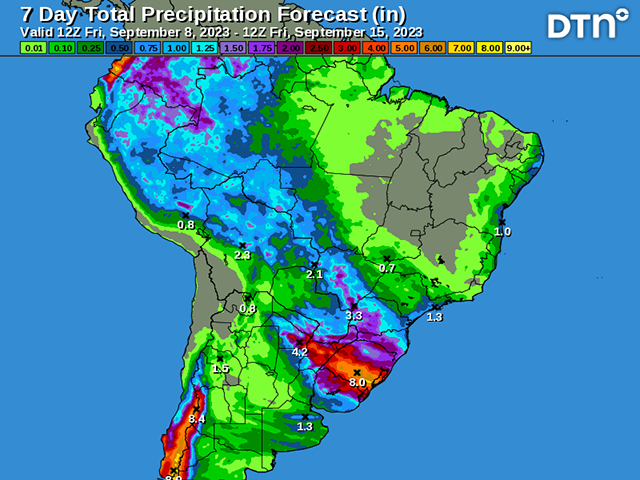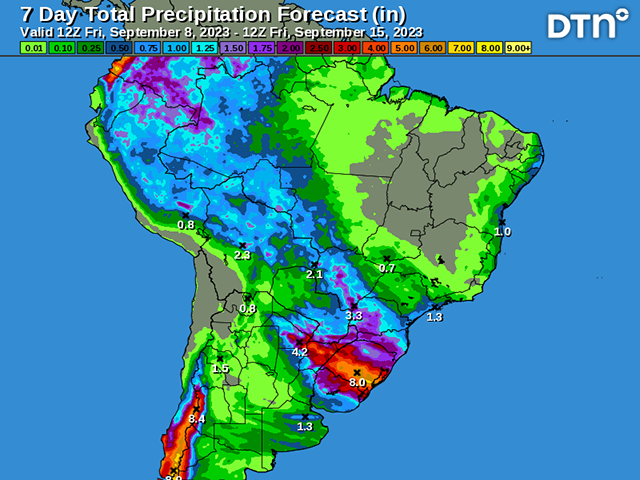Ag Weather Forum
More Heavy Rain Coming for Southern Brazil as Planting Season Begins
The weather pattern has certainly been more active over the last month or so in South America. El Nino's influence has certainly been picking up and the usual pattern of above-normal rainfall that falls over Argentina and southern Brazil has come to bear thus far.
For producers in southern Brazil states of Rio Grande do Sul, Santa Catarina, and Parana, the rainfall has been heavy. Over the last week, satellite estimates of 50 millimeters to 100 mm (about 2 to 4 inches) have fallen in much of the region, and in Rio Grande do Sul in particular has seen some amounts eclipsing 100 mm. This area grows a lot of winter wheat, which is currently in the reproductive and filling stages of growth. Some flood damage may have occurred in these areas already. The rain may not have been as heavy in Parana, where estimates of 25 mm to 75 mm (about 1 to 3 inches) have fallen over the last week, but there is still a good portion of last season's safrinha (second season) corn that is mature and awaiting harvest in that state. According to the government of Parana, 21% of the safrinha corn is still in the field and will need to be harvested quickly before soybean planting can begin.
Another system will be moving through the region early next week and models are producing another round of heavy rain, particularly in southern Rio Grande do Sul. Estimates of another 25 mm to 75 mm for Parana and 50 mm to 100 mm for Rio Grande do Sul are being forecast. Again, with localized amounts well over 100 mm in southern Rio Grande do Sul. Both Parana and Rio Grande do Sul are responsible for about 15% of the total corn and soybean production in Brazil each and their weather situation will be closely monitored. These two states have different methods of farming and will approach the incoming rainfall differently.
ISSUES FOR PARANA
The state of Parana is close enough to the equator they do not experience much of a cold season. Thus, the growing season is typically good enough to double-crop soybeans and corn in the same calendar year. Most producers do, though there are some that go with a different rotation. Some frosts are possible in June and July, but that is usually a rare occurrence and the safrinha corn is usually mature by then anyway. To start planting soybeans, producers are limited by law to wait until Sept. 11. But they need their safrinha corn out of the field first. Though rainfall has increased significantly in recent weeks, producers in Parana have been making progress on the safrinha corn harvest anyway. Two weeks ago, the harvest was only 48% complete. It currently stands at 79% as of early this week. Still, that is a lot of corn to pull out of fields before soybean planting can begin.
P[L1] D[0x0] M[300x250] OOP[F] ADUNIT[] T[]
Heavy rainfall now is likely to keep producers waiting a bit more and quality may go down. Soil moisture will also be very high as producers start planting, which may cause issues with equipment and slow progress. If soybean planting is significantly delayed, that could shorten the window for the safrinha crop for early 2024.
ISSUES FOR RIO GRANDE DO SUL
The state of Rio Grande do Sul farms much like the southern Midwest or Delta region. Farmers either choose a single long-season corn variety, or double-crop a short winter grain like wheat with soybeans. The weather is great for a long season, but cold over the winter limits potential for double-cropping corn and soybeans like Parana.
Winter wheat, or barley, that was planted in May and June is in its filling stages and should mature at the end of September. Heavy rain has been great for soil moisture but may be causing issues with lodging and flooding. Producers may have some difficulty with soybean planting if it takes too long for the crop to dry down and mature. Soils in the state are generally sandier and can drain more efficiently, but rainfall of this magnitude -- already seen and also forecast -- certainly won't help.
Corn planting has already begun and flooding may cause some producers the need to replant. Others may need to wait longer. With the long growing season, those choosing a single crop may fare better than double croppers, though the above-normal precipitation through the growing season thanks to El Nino may negate the early production concerns.
To find more international weather conditions and your local forecast from DTN, visit https://www.dtnpf.com/….
John Baranick can be reached at john.baranick@dtn.com
(c) Copyright 2023 DTN, LLC. All rights reserved.






Comments
To comment, please Log In or Join our Community .